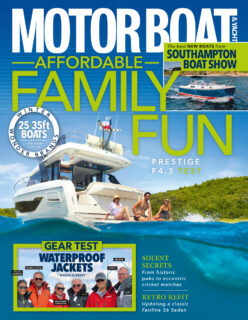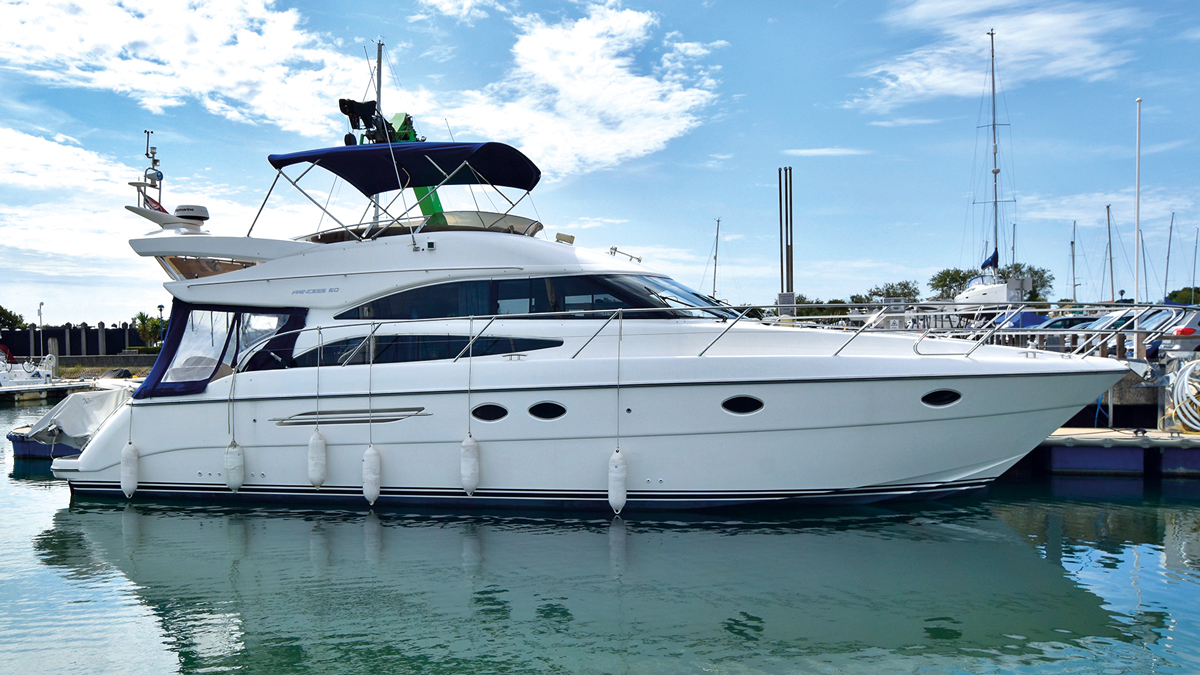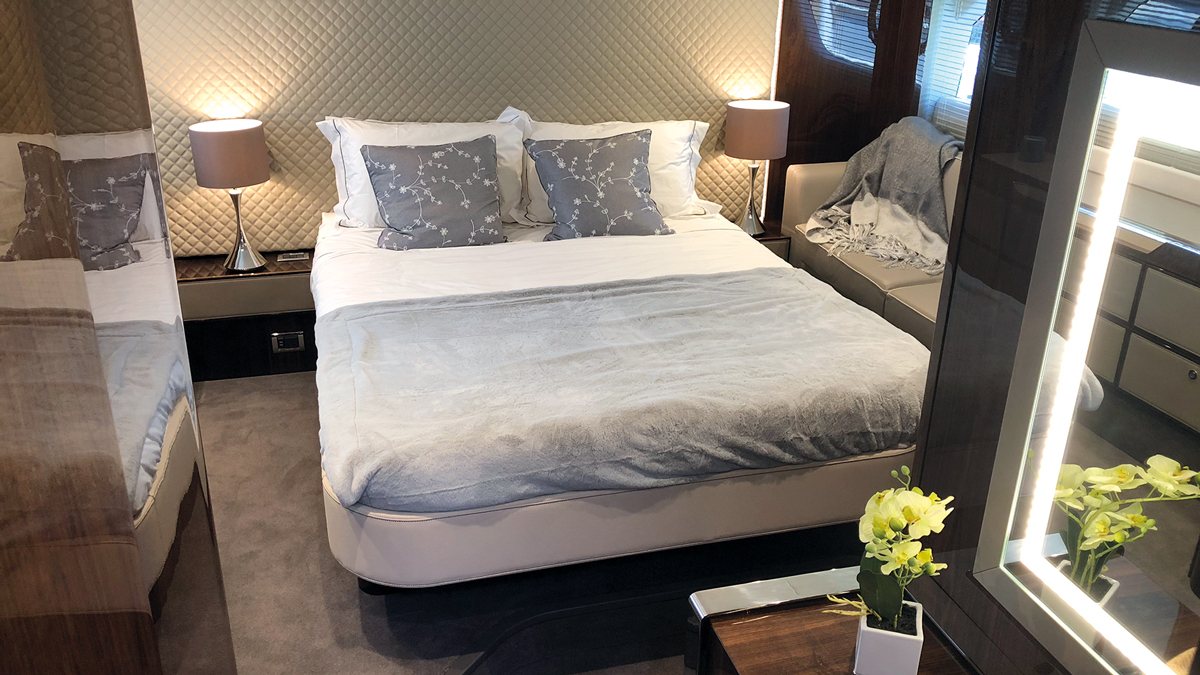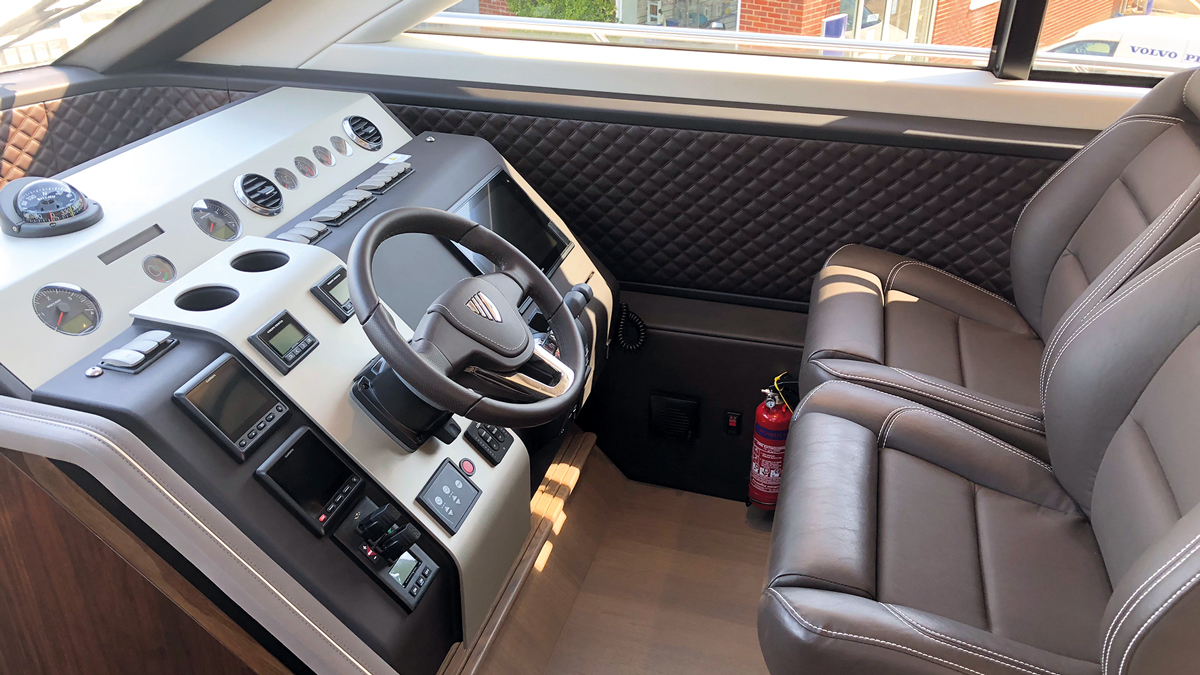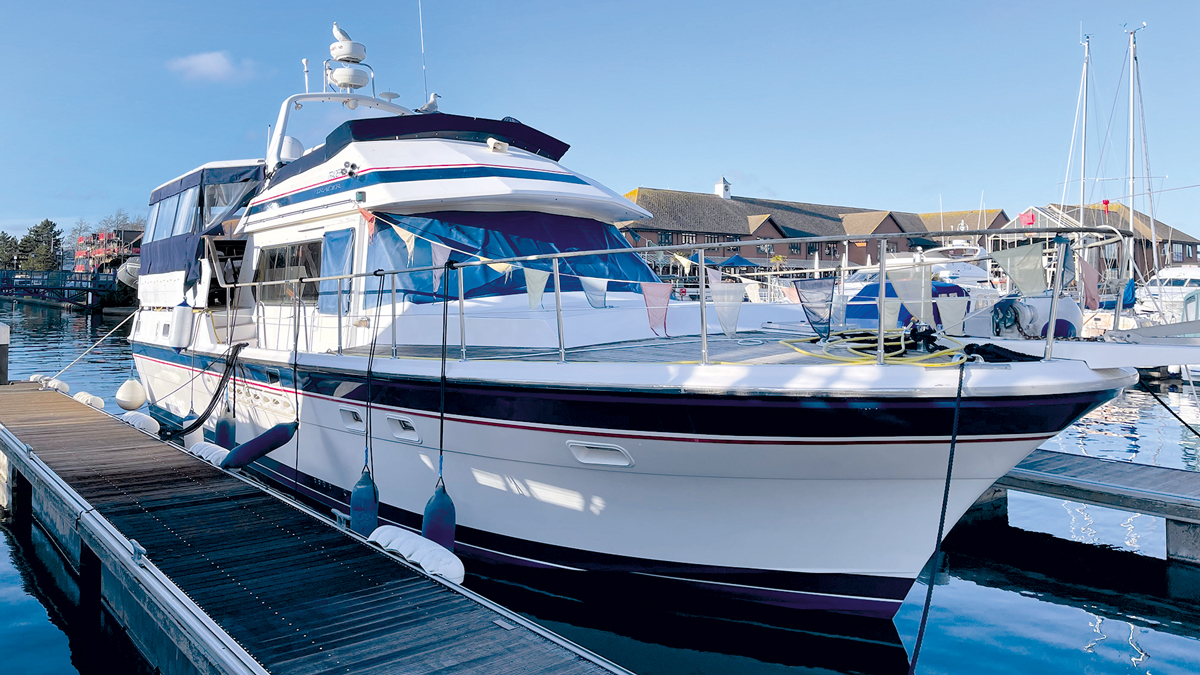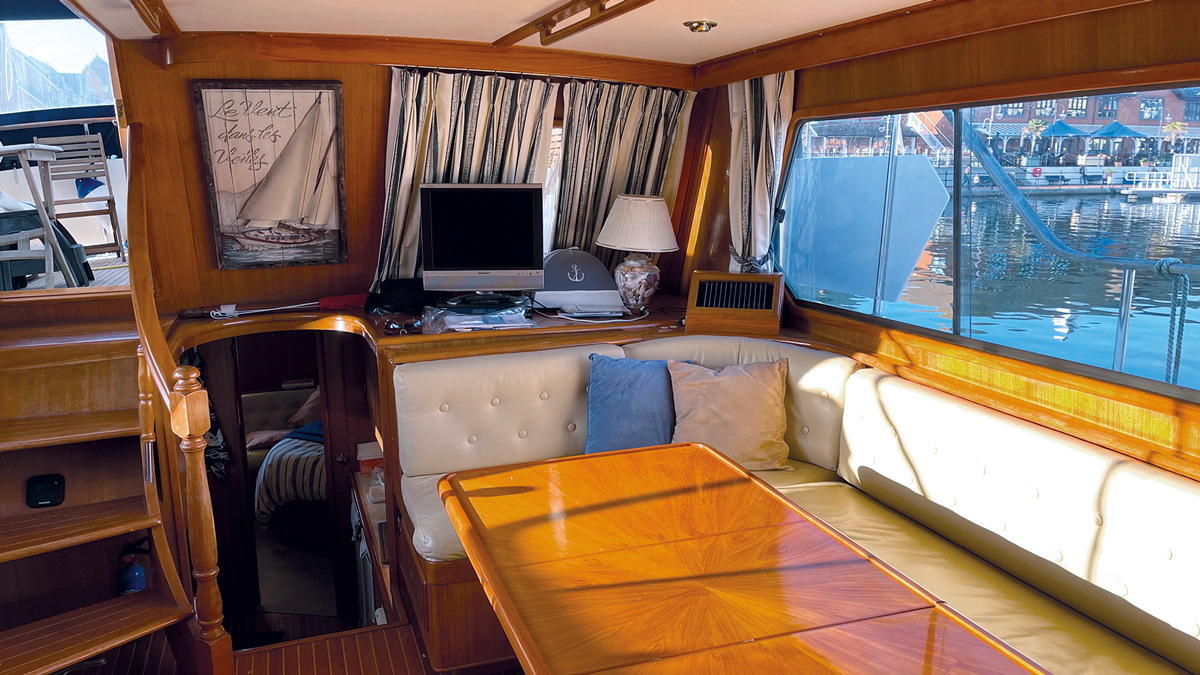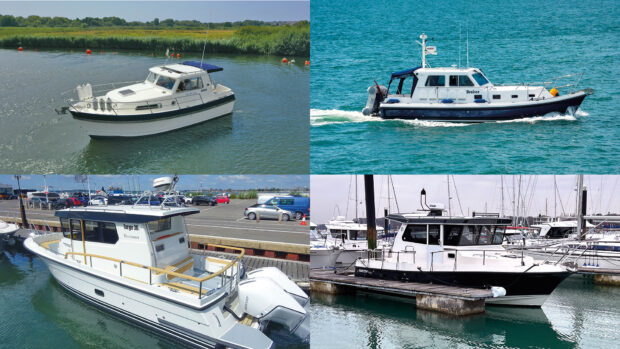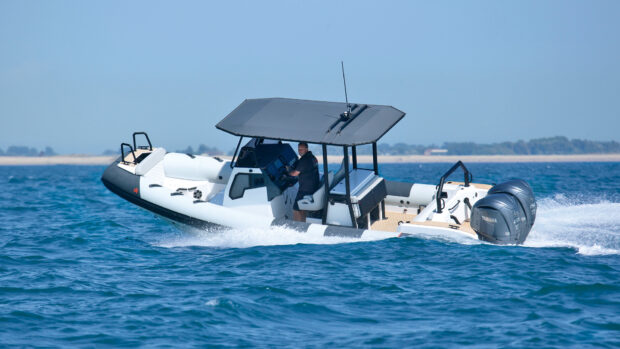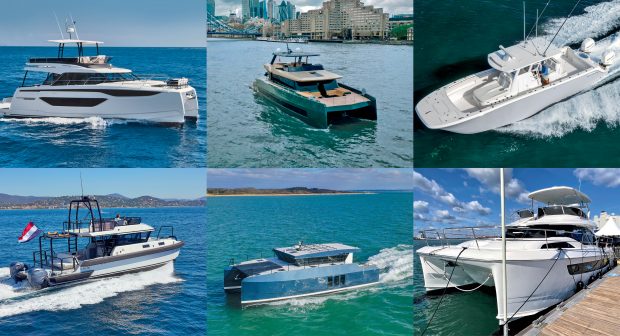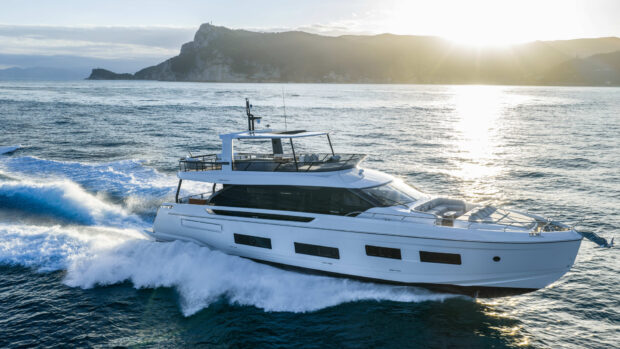Our resident used boat expert Nick Burnham picks out four of the best 50ft flybridge boats for sale right now, from the likes of Princess, Fairline, Sealine and Beneteau.
50ft flybridges are fascinating for many reasons. Firstly, 50ft is a size that is relatively easy to manage from a boat handling point of view.
Two reasonably experienced people should be able to cope with berthing and running such a boat. Secondly, 50ft is a very handy size from an accessibility point of view. Most marinas, harbours and coves should be able to find space for a 50ft flybridge cruiser.
However, 50ft is also the size at which you start to get three good sized cabins and at least a couple of bathrooms. Some yards manage to squeeze the proverbial quart into a pint pot by shoehorning three cabins into a 45-footer but at 50ft no squeezing is required.
Here are four particularly good examples…
4 of the best 50ft flybridges on the market

Princess 55
Built: 1987
Price: £169,950
We’re cheating slightly with a 55ft boat but we couldn’t resist this one. It’s hard to believe that when the 55 launched in 1986, it was the pinnacle, not only of Princess Yachts’ range, but also of British boat building.
Birchwood (remember them?) eclipsed it soon after with its 57, but the Princess 55 proved a very worthy flagship. Eight boats a year were planned but by the end of the first year of production, 12 had been built and orders stretched two years into the future.
Interior
While not as clever as modern boats (for example, there was little layering of the accommodation, where the lower deck extends back under the main deck), the sheer size of this one makes for masses of onboard space.
One of the most obvious upgrades over the Princess 45 (the previous flagship of the range) was the separate dinette area on the main deck. This boat has the three-cabin, two-heads layout, with the owner’s cabin forward, a bunk cabin to port and a larger double guest cabin to starboard (twin berths were standard).
A rare option was to lose the bunk cabin in favour of an extended owner’s cabin. But the crew cabin on this boat has been swapped for a useful utility room.

This boat has the three-cabin layout, with a larger double guest cabin than the usual twin
Exterior
The 1980s square-edged origami-styling looks classic rather than dated now. The bolt-on bathing platform, the lack of a transom door and the ladder to the flybridge are all very much of the era.
Performance
We tested the Princess 55 when new with a pair of 358hp Volvo Penta TAMD 71A engines and achieved 23 knots. This particular boat was re-engined in 2014 with a pair of FPT N67 450hp diesel engines which lifted the maximum speed to 26 knots.

The separate dinette area is an obvious upgrade from the 45 – the previous flagship
Seakeeping
We conducted our sea trial in a Force 6-7, reporting that “when we reduced speed to 15 knots, we made progress upwind in remarkable comfort”.
Specifications
LOA: 55ft 5in (16.9m)
Beam: 15ft 8in (4.8m)
Draught: 3ft 6in (1.1m)
Displacement: 16 tonnes
Fuel capacity: 1,910 litres
Engines: Twin FPT N67 450hp diesels
Location: Norfolk
Contact: Norfolk Yacht Agency
Article continues below…

Best 40ft flybridges: Our pick of the secondhand market

Secondhand boat buyers’ guide: 4 of the best 45ft flybridge yachts for sale
Sealine T50
Built: 2007
Price: £299,950
Sealine has been responsible for many of the innovations we take for granted on modern boats. It came up with the idea of stairs to the flybridge rather than a ladder, for example.
Its Sealine T50 was one of the first boats to develop the now universally accepted premise that, if you want to create more internal volume within a set length, one of the most effective ways to achieve this is to build upwards.
Interior
The result is a very tall boat for its era (although not by current standards) which creates a surprising amount of space.
The lower deck sports similar accommodation to the larger Princess 55, with two double cabins plus a bunked third cabin and two heads, but Sealine used the extra height to move the owner’s cabin back beneath the forward end of the split-level main deck, layering the accommodation to create more volume and a larger cabin.
The stand-out feature is in the saloon, where Sealine was one of the first to have the now ubiquitous galley-aft layout.

The owner’s cabin has been moved back beneath the forward end of the split-level main deck
Exterior
The flybridge (accessed, of course, by a stairway) of the Sealine T50 is huge. When we tested the boat we referred to it as “like a 30ft sportscruiser sitting on top of a 50ft motor yacht”.
Sealine’s SECS extending cockpit system was another innovation, allowing the transom to slide back to create more space at anchor. The only real compromise on this boat is storage. There is no conventional lazarette. Owners had to choose instead between a small crew cabin and a large storage space.
Performance
Engine choices when new were twin shaft-drive installations of either Cummins QSC 8.3 540hps or Volvo Penta’s D9s in either 500hp or 575hp flavours. This boat has the largest option, as did our test boat, hence a 33 knot max.

The galley-aft saloon layout was groundbreaking but has now become ubiquitous in 50-footers
Seakeeping
Ocke Mannerfelt designed the hull and succeeded in creating a responsive and fun drive.
Specifications
LOA: 50ft 4in (15.3m)
Beam: 15ft 7in (4.8m)
Draught: 3ft 6in (1.1m)
Displacement: 18 tonnes
Fuel capacity: 2,000 litres
Engines: Twin Volvo Penta D9 575hp diesels
Location: Falmouth
Contact: Red Ensign
Fairline Phantom 50
Built: 2006
Price: £294,950
While Fairline Targa boats are sportscruisers and the Squadron moniker is reserved for large flybridge vessels, what’s interesting is that Fairline also used to have a third line of smaller flybridge boats that were dubbed Phantom.
The idea of buying a 50ft half-a-million-pound flybridge cruiser and having it badged as the ‘lesser’ model seems a little absurd now. But intriguingly, the Phantom badge has now been reintroduced for Fairline’s new sportfly boats.
Interior
High-gloss cherry surfaces, leather and other fine finishes reassure you that you’re in a high-quality environment. Early boats had a slightly odd bar area directly behind the lower helm, later dropped for Mk2 versions like this one.
Here, we have more seating as a result and a slightly different galley layout that opens aft rather than to the side. Both versions had the galley up on the main deck alongside the helm, freeing up space on the lower deck for a three-cabin and two-head layout with the owner’s cabin forward.
All three cabins feature double berths on this boat, although the standard layout had a pair of single beds in one of the guest cabins. A small crew cabin was also an option beneath the cockpit seating aft.

Each of the three cabins on this Phantom 50 features double beds
Exterior
The Fairline Phantom 50 is a very simple, elegant-looking vessel with no sense that it’s trying too hard. There’s nothing that stands out as especially clever. It’s just a tried-and-tested set-up that works well.
The tender lives on the bathing platform, hoisted into place by a passerelle. The central flybridge helm is flanked by a pair of seats and there’s also a large seating zone around the table further aft.
Performance
Early Phantom 50s got a pair of D12 675 motors, later boats the upgraded D12 725. Caterpillar 3196 669hp engines were a rare alternative, and Cummins was on the options list but none of the 126 examples went out with these. Either option should return more than 30 knots.

Cream leather and glossy cherry wood cabinetry
creates an expensive feel
Seakeeping
A shaft-drive Fairline with an Olesinski hull means you know it’s going to be OK. And so it proved.
Specifications
LOA: 51ft 10in (15.8m)
Beam: 14ft 9in (4.5m)
Draught: 4ft 1in (1.2m)
Displacement: 20 tonnes
Fuel capacity: 1,980 litres
Engines: Twin Volvo Penta D9 715 715hp diesels
Location: Essex
Contact: boats.co.uk

Monte Carlo 5
Built: 2014
Price: £534,950
Beneteau is a very successful mass producer of boats from 19ft upwards – and that’s all splendid. But that does cause a slight issue when it tries to turn its hand to high-end production boats, because it simply doesn’t have the image to compete with the likes of Princess or Sunseeker.
However, among its armament of boat brands, Beneteau owns an Italian company called Monte Carlo Yachts, which builds boats from about 70ft to beyond 100ft.
It decided to call its high-end 50ft+ production boats Monte Carlo, or MC for short, even though they’re built by Beneteau in France. What we have here then is the 50-footer, hence Monte Carlo 5 – or MC5.
Interior
A galley-aft layout sees the main deck split across three levels, with a shallow step between each one as it rises gently going forward. It will come as no surprise to you, if you’ve read this article from the start, to hear that the lower deck sports a three-cabin two-heads layout.
But being such a recent boat, this is pretty much the current state-of-the-art model, with a huge full-beam owner’s cabin in the centre, plus a VIP guest cabin forward and a third cabin with bunk beds.

The full-beam master is even larger than this VIP cabin
Exterior
When Beneteau launched the MC5, it wowed the world with its vibrant turquoise topsides and large, stainless steel-edged circular hull windows. In fact, the latter was very reminiscent of Monte Carlo Yachts (the other Monte Carlo…).
Other hull colours came on stream, including the rather more discreet colour you see here. And high decks are now standard issue across most flybridge boats of this size in order to accommodate that big owner’s cabin.
Performance
All that bulk gives great space but takes its toll a little on performance. Twin IPS500 and IPS600 engines were offered on launch. The best is the IPS600 option that this boat has. Top speed is about 28 knots with a mid-20 knot cruise.

Equipped with IPS600s, the MC5 will hit speeds in the region of 28 knots
Seakeeping
“The ride is excellent; soft and planted but with just enough tenacity from the pods to make things interesting – and amazingly dry,” said our man in Cannes when he tested the MC5.
Specifications
LOA: 49ft 10in (15.2m)
Beam: 14ft 1in (4.3m)
Draught: 3ft 1in (1.0m)
Displacement: 15 tonnes
Fuel capacity: 1,300 litres
Engines: Twin Volvo Penta IPS600 435hp diesels
Location: Southampton
Contact: Solent Motor Yachts
First published in the December 2022 issue of MBY.
4 more 50ft flybridge boats from the May 2022 issue
Sunseeker Manhattan 48
Built: 1996
Price: £155,000
The smallest of the Manhattan range of flybridge cruisers when introduced, this model was launched as the 45 before quickly becoming the 46.
An extended bathing platform resulted in a further badge change to the Manhattan 48 you see here.
Interior
Never ones to follow the herd, Sunseeker used vee drives instead of the shaft drives far more commonly seen on 50ft flybridges of this era.
It put the engines back beneath the cockpit rather than under the saloon floor, and that created an equally unusual layout.
With an ensuite owner’s cabin up in the bow and a decent twin-bedded guest cabin opposite the galley linked to the day heads, it feels like you’re all done on the lower deck.
But aft of the galley is another door granting access to a third cabin with a double berth running transversely beneath the main deck saloon in the space you’d usually find the engines.
Exterior
Sunseeker went for a real motoryacht style with this one, so you get aircraft-style wrap-around windscreens and slatted saloon side windows.
Back aft, that extended platform allows you to sit a tender on the deck rather than hanging from davits as per the earlier 46 and 45, and there is a passerelle that can be utilised as a dinghy crane.
Although new enough to get the long platform, it just predates the flybridge stairs, so you have to climb a ladder to a pretty decent flybridge, complete with period winged radar arch.
Performance
Sunseeker fitted twin engines from 430hp aside up to 600hp each, which were reckoned to give a mid 30 knot top end.
We tested the boat (actually the earlier Sunseeker Manhattan 46) with similar Caterpillar 3208TA engines fitted to this example and achieved a still spritely 29 knots, making 20 knots an easy and relaxed cruising speed.
Seakeeping
Four chunky lever controls at each helm (two for FNR gear shifting, two for throttles) give the brain more of a work out but repay with greater precision than traditional twin levers, and a bow thruster helps at close quarters.
In an earlier test we described the boat as having “smooth riding qualities” and impressive directional stability.
Specifications
LOA: 47ft 11in (14.6m)
Beam: 14ft 5in (4.4m)
Draught: 3ft 7in (1.1m)
Displacement: 14 tonnes
Fuel capacity: 1,400 litres
Engines: Twin Caterpillar 3208TA 435hp diesels
Location: Portland
Contact: Network Yacht Brokers
Princess 50
Built: 2005
Price: £300,000
The Princess 480 had enjoyed a damn good run by the time it was finally pensioned off in 1999. A very gentle evolution of the 470 (extended bathing platform), that model had initially been launched as the 455 back in 1991, a boat with big shoes to fill as it replaced the seminal Princess 45.
In fact the 455 mirrored the 45, with an almost identical layout, so the concept actually stretched back to 1982. Hence a complete “keel-up” refresh was needed, and the Princess 50, launched in 2000, was it.
Interior
Pre-dating full beam owner’s cabins (although, the later MK3 version did introduce one at a later date), the first Princess 50 had two similar sized cabins at either end of the lower deck, plus a smaller twin bunked cabin in between.
The forward cabin was designated the master with its centreline double berth. Cabin two, meanwhile, could be optioned with twins or a double.
Unlike its predecessor, there was no lower deck dinette option because the galley had been raised almost to main deck height, increasing space in cabin three and making the galley more sociable.
Exterior
A whole new model ushered in an entirely new look – the 50 was a far more modern looking boat than the earlier 480.
In 2005 Princess Yachts introduced the MK2 version of the 50 you see here, but the upgrades are predominantly cosmetic changes, such as a new-style radar arch and less stainless steel trim on the saloon window surrounds rather than the wholesale reinvention that came in when the MK3 was introduced.
Performance
The year 2005 also ushered in Volvo Penta’s brand new D series engines to replace the venerable TAMD units.
In the case of the Princess 50, that meant twin D9 motors of 500 or 575hp each or D12 675hp rather than the TAMD 74 480hp units we tested the boat with at launch.
We achieved 29 knots, so the 32 knots claimed for the far more powerful D9-575 units of this boat seems entirely reasonable.
Seakeeping
The conventional shaft drive and an Olesinski hull means you can’t go wrong. The boat flattened a moderate sea with “consummate ease” and well-managed spray.
Specifications
LOA: 50ft 3in (15.3m)
Beam: 14ft 8in (4.5m)
Draught: 3ft 8in (1.1m)
Displacement: 19 tonnes
Fuel capacity: 1,818 litres
Engines: Twin Volvo Penta D9 575 575hp diesel engines
Location: Lymington
Contact: Sunseeker Brokerage
Fairline Squadron 53
Built: 2018
Price: £999,950
The Fairline Squadron 53 marked a return to a high-end finish for a marque once fabled for its interior detailing.
From the mirror finish of the high gloss cabinetry and stainless steel detailing to the soft-touch finishes inside the helm, this looks and feels like an expensive boat.
Interior
It’s not just the finishes that set the Squadron 53 apart, it’s also the breadth of customisation available when these boats were ordered new. The galley, for example, could be specified aft on the main deck, as is currently fashionable, or further forward.
Or it could be moved to the lower deck instead of a fourth cabin, where you could choose between a full-sized galley or a smaller galley plus a third heads.
The space it vacated on the main deck was then filled with an extra settee or sideboard. This boat is the four-cabin version with the galley aft and the optional crew cabin fit out (taking total sleeping to nine, all in permanent berths spread across five cabins in total!)
Exterior
All that talk of cabins might lead you to think that there can’t be much deck space but in fact the cockpit is huge – as long, possibly longer in fact, than it is wide.
There’s also a further cockpit area on the bow with a fold-out table and sunpads, plus the flybridge which has open tread steps with lighting neatly built into them.
Performance
There is plenty of choice when it comes to engines, too, all of which are twin installations. Caterpillar C12.9 give 850hp each, or alternatively there are Volvo Penta D11s with 675hp or 725hp each side.
We tried it with the same twin Volvo Penta D11-725 EVC motors fitted to this boat. Running conventional shaft drives, we achieved a top speed of 33 knots, slightly up on the manufacturer’s claimed 32 knots, and that was with a Williams 325 tender on the bathing platform plus gyro stabiliser, full water tanks and 75% fuel. Pretty impressive stuff.
Seakeeping
“Smooth and quick-witted” is how we described the handling during our test of the Fairline Squadron 53, with “a confident and sure-footed hull that soaks up bumps extremely well.”
Specifications
LOA: 55ft 6in (15.9m)
Beam: 14ft 10in (4.5m)
Draught: 3ft 11in (1.2m)
Displacement: 21 tonnes
Fuel capacity: 2,412 litres
Engines: Twin Volvo Penta D11-725 EVC diesel engines
Location: Southampton
Contact: Bates Wharf
Tarquin Trader 50
Built: 1992
Price: £169,950
If the number one priority for your choice of 50ft flybridge cruiser is space then you have come to the right place because this boat is vast in every dimension. It’s 15ft across, sits 5ft deep in the water and towers above you in a marina.
Interior
As if the sheer physical dimensions weren’t enough, Tarquin gained yet more volume by taking the accommodation the full length of the boat. So there’s a palatial master cabin in the stern nuzzled right up to the inside of the transom and stretching the full beam of the boat.
Interestingly, Tarquin used the area of lower deck ahead of it to give a large ensuite (complete with small bath) on the port side, but a galley to starboard, which would be very handy for midnight snacks!
It means that the large saloon on the main deck, which plays host to a huge C-shaped dinette as well as the lower helm, splits off the forward lower deck area creating great privacy for the owner.
At the pointy end there is a generous VIP guest cabin forward with vee berths plus a twin-bunked cabin, although both of these cabins share the same day heads.
Exterior
Running the accommodation the full length of the hull might pay dividends inside, but it can sometimes compromise the exterior as an aft cockpit is off the menu, replaced by a raised deck above the aft cabin.
In this case Tarquin has been quite cunning. As well as surrounding this space with a sturdy GRP dodger, the designers have also sheltered it with a huge hardtop, which in turn allows canopies to encircle this area.
Performance
Despite having very similar engines to the Sunseeker (the same units in fact, just detuned slightly), this boat wouldn’t see where the Sunseeker went. But that’s okay, because it just isn’t that sort of boat – a point underscored by the fact that the base engines were a pair of 210hp Ford diesels.
A pair of 450hp Volvo Pentas were at the other extreme, this boat sits in the middle with a pair of 375hp Caterpillars capable of achieving mid-teen speeds.
Seakeeping
Handling is regal rather than sporty, although these boats can tend to roll a bit.
Specifications
LOA: 49ft 6in (15.1m)
Beam: 15ft 0in (4.6m)
Draught: 5ft 1in (1.5m)
Displacement: 20 tonnes
Fuel capacity: 2,270 litres
Engines: Twin Caterpillar 3208TA 375hp diesels
Location: Eastbourne
Contact: Bates Wharf
3 more 50ft flybridge boats from the May 2018 issue
PRESTIGE 500
2015 £584,050

When the 500 launched in 2011, it was a bit of a game changer. From the hull windows instead of portholes to the mirrored saloon glazing and taut clean lines, it was very much a product of the Teenies. But the real game changing took place inside.
INTERIOR
The galley-aft layout, putting the kitchen directly inside the saloon doors, whilst modern, was nothing new, although the one-piece glazing either side of the saloon is pretty swish.

What was unique on an aft- cockpit flybridge cruiser just under 50ft was separate access to the master. The forward companionway leading to cabins two and three is in its usual place forward of the saloon, but to reach the owner’s quarters you need to hook a sharp right as you pass through the saloon doors to your own private stairway.
A useful corollary of this layout is a narrower forward passageway as it no longer has to allow access aft, resulting in twin beds rather than bunks in cabin three.

EXTERIOR
Unusually, the saloon doors slide in both directions. Slid one way, they make an easy route from saloon to cockpit, slid the other, they give direct access to the galley.

On the flybridge, creating more headroom inside results in a large sunpad next to the double helm. But that still leaves space for a generous L-shaped dinette further aft.
PERFORMANCE
Twin Volvo Penta IPS600s gave 435hp aside for a top end of 28.5 knots when we tested it, for 20-25 knots of cruise speed.
SEAKEEPING
A main benefit of IPS is siting the engines further aft than traditional shaftdrive, which is what creates space for the big mid cabins.
Unusually though, Prestige chose to sacrifice a little of that by positioning the engines slightly further forward and linking to the pods with jack shafts. Doing so moves the centre of gravity forward to keep the bow planted.
DATA
Length 49ft 10in (15.2m)
Beam 14ft 9in (4.5m)
Draught 3ft 5in (1.1m)
Displacement 13.5 tonnes
Fuel capacity 286 gallons (1,300 litres)
Engines Twin Volvo Penta IPS600 435hp diesel
FAIRLINE SQUADRON 52
2000 £249,950

The Squadron 52 is a great example of the confidence Fairline portrayed at the turn of the century.
Rather than another three-cabin cruiser, Fairline set out to produce a mini superyacht aimed at luxury and comfort rather than maximising sleeping space. The result was an intriguing, offbeat alternative to the mainstream.
INTERIOR
The best thing is two huge cabins rather than three, almost unheard of for a boat in this sector. There’s no obvious master cabin but both are equally spacious and luxurious.

Ensuites include separate shower stalls and even bidets – rare on anything under 80ft! On the main deck, the helmsman is surrounded by a console that wouldn’t look out of place on the Starship Enterprise, and the saloon and dinette are a feast of gentle curves, highly lacquered cherry and cream vinyl and carpet.
You’ll find a galley tucked away low down on the port side and even a small utility room off it complete with washing machine.
EXTERIOR
The curved and fluted aft-side sections of the superstructure look fantastic and ease access to the side decks. The flybridge gets a vertical mast- style radar support rather than the ubiquitous arch, and the stanchions supporting the deck rails are similarly superyacht vertical rather than canted forward.

Add the imperiously aircraft-styled sweep of curved glass around the helm and you end up with a boat that exudes class and style and stands the test of time.
PERFORMANCE
Caterpillar 3196TAs were an option but most got twin Volvo Pentas, earlier boats the TAMD122s at 610hp a side, later ones the electronically controlled D12s at 675hp each. All these options should be achieving circa-30 knots, the D12 with a little more economy.

SEAKEEPING
Classic Olesinski hull design combines with classic shaftdrive layout to create reassuring heavy-weather handling with steady directional stability.
DATA
Length 49ft 10in (15.2m)
Beam 14ft 9in (4.5m)
Draught 3ft 5in (1.1m)
Displacement 13.5 tonnes
Fuel capacity 286 gallons (1,300 litres)
Engines Twin Volvo Penta IPS600 435hp diesel
PRINCESS 500
1992 £125,750

Launched in 1991 and a mild (mostly cosmetic) evolution of the Princess 48 that launched a year earlier, the 500 was the first of a new ’90s styling wave for Princess, introducing sexy curved windscreens in place of the squared-off designs of earlier boats and toning down the distinctive but dated double-knuckle hull moulding halfway up the topsides of ’80s boats.
INTERIOR
In production during the introduction of Princess’s high-gloss burr maple ‘superyacht’ finishes, the busy-looking woodwork looks rather dated now.
This boat just predates the era, being fitted out in tasteful grained light oak, the alternative to standard teak. But the big news (literally) is just how huge the interior is on this boat.

The saloon is massive – there’s a generous galley that hovers neatly twixt main and lower decks. On the lower deck, the master is forward, with matching twin-berthed cabins either side. A twin-berthed crew cabin beneath the cockpit seating was a popular option.

EXTERIOR
Twin slats on the aft saloon side windows are the key differentiator between the 500 and the short-lived 48, though the boat is actually slightly longer.
It’s of the era that gets the transom door but not the moulded steps to the flybridge, so it’s a raked ladder to the top deck, but masses of space once you get there.
PERFORMANCE
Engineering is reassuringly classic – simple shafts linked to large-capacity diesel engines. Princess fitted Volvo Penta or Caterpillar, the latter being the big V8 3208TA 435hp motors, the green (at least in colour) option fitted to this boat being the straight six TAMD 72 430hp motors.

Both options should give a mid-20-knot maximum with a 20-knot cruise.
SEAKEEPING
Shaftdrive and Olesinski hull means steady predictable handling and seakeeping, combining a soft ride with excellent directional stability.
DATA
Length 52ft 5in (16.0m)
Beam 14ft 7in (4.5m)
Draught 4ft 0in (1.1m)
Displacement 17 tonnes
Fuel capacity 385 gallons (1,750 litres)
Engines Volvo Penta TAMD 72 430hp diesel
If you enjoyed this…
Be first to all the latest boats, gadgets, cruising ideas, buying advice and readers’ adventures with a subscription to Motor Boat & Yachting. Available in both print and digital formats, our monthly magazine will be sent directly to your home or device at a substantial discount to the usual cover price. See our latest offers and save at least 30% off the cover price.
